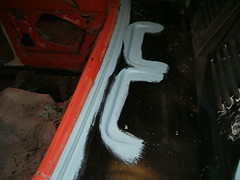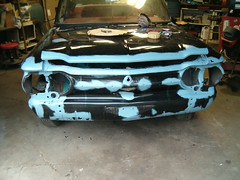

Since I’ve been playing musical chairs with carburetors – swapping between Lucy and Glinda and rebuilding ones on the shelf – I didn’t know which two of the five carbs I have on the shelf would be the best for Ringo’s rebuilt engine. To alleviate this condition, I used Glinda as my test mule. A while back, I’d swapped one of my racing carburetors onto the driver’s side of the Glinda’s engine to try and fix a problem that ended up not being carb related. That carburetor was still on Glinda, so I pulled it off and marked it good. Next I put on a recently repaired carburetor. This was one that used to be on Lucy, but had a vacuum leak that caused that side of the engine to run lean and overheat. I found that a worn throttle shaft was the cause, so I fixed this by implementing the o-ring/washer/spring repair you can read about here. That carb checked out fine on Glinda, so off it came and on went one that I’d marked with the word “Good”. Well, it wasn’t. By the way, I should note here that my method of testing was removing the main throttle shaft so each carburetor could be operated independently. After running the engine for a few seconds, the bowl in the new carb had filled with gas, and I could blip the throttle linkage on that one or the other carb (or both) and saw how the engine responded. Equal and lag-free response was what I was looking for. With the supposedly good carb, the engine started bogging about twenty seconds after I knew the bowl was full. I shut off the engine and noticed gas running into the venture. Stuck needle. I pulled the top assembly off the carb, checked the needle and seat and found it would hang up due to the little wire linkage that attaches the needle to the float. I removed that piece which I don’t think is really necessary anyway, put the carb back together, started the engine, and everything worked wonderfully. Yes! The next one to go was one that had the word “Rebuilt” on it, and it had the same flooding issue. Off came the top, off came the linkage, back on went the top, and the flooding issue was gone and the engine responded well to throttle blips. Then it was time to put an unknown entity on. This carb had no writing on it. I found the problem with it was a faulty accelerator pump – no little jet of fuel when the throttle is blipped. Since I didn’t have a replacement cup for the pump, I removed this carb for future work and bolted Glinda’s original, repaired carb. After balancing the carburetors and putting the air cleaner assembly back together, I had Victoria take Glinda for a spin around the neighborhood. She came back complaining the idle speed was too high. I hooked up my portable dwellmeter/tachometer and backed down the screws until the speed in Drive was 500 rpm. She drove the car again last night and had no complaints so I guess it’s performing satisfactorily. It will be interesting to see if putting the original ’68 carb will have an impact on the fuel mileage.
A couple issues I discovered and addressed on Glinda while I was using her were a faulty brake light (ended up being a loose socket that I tightened) and broken air cleaner gasket. The latter was a little scary since the engine was trying to suck the part into itself. I didn’t have a replacement, so I just bolted the cleaner assembly back on without a gasket for the time being. It fits quite closely, so it’s a low-risk solution.
With Glinda roadworthy, I installed two of the tested carburetors on Ringo’s engine. One step closer to having his rebuilt engine make its maiden run.

No comments:
Post a Comment